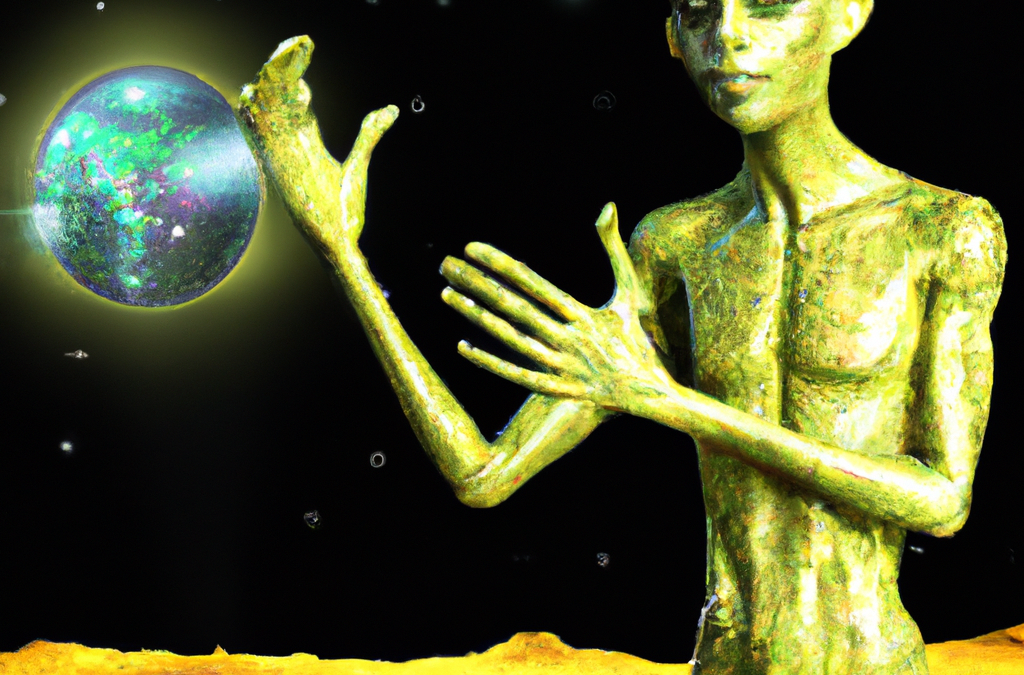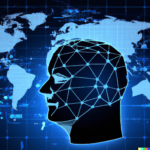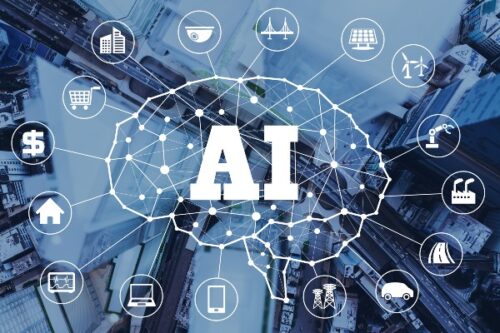
Crypto is Libertarian and AI is Communist
“Crypto is decentralizing, AI is centralizing. Or, if you want to frame it more ideologically, crypto is libertarian and AI is communist.” – Peter Thiel

AI-generated image
Produced by DALL-E by OpenAI Labs
Using the prompt:
“Abundance vs. Self-expression”
AI and Crypto are diametrically opposed to each other, yet can complement each other in incredibly useful ways when joining forces. Maybe that’s true of most diametrically opposed forces? That’s a discussion for a different blog post.
Four differentiations to consider:
Control vs. Coordination
- AI is top-down; strongest when information and control are centralized.
- Crypto is bottom-up; strongest when information and coordination are decentralized.
Status Quo vs. Disruption
- AI sustains the status quo and reinforces the strength of existing businesses.
- Crypto disrupts existing business models and helps fringe efforts challenge existing businesses.
Conformity vs. Individualism
- AI reinforces behavior in accordance with accepted conventions or standards.
- Crypto increases privacy and empowers self-sovereignty.
Abundance vs. Self-expression
- AI creates an abundance of media and machine-generated creations.
- Crypto enables self-expression and verifies human identity.
Now that we’ve laid out how they differ, what are some ways they can work together?
Code Creation
Crypto projects – like any software development – rely on well-written computer code. AI is a useful tool for writing computer code. Tool is a key word here. AI is an incredibly powerful tool, but it does not (yet) replace the need for a human to properly utilize the tool.
One major weakness in AI-generated code is security; or a lack thereof. AI is going to suggest methods it finds within its data. As anyone who is one of the billions of people who has had their information compromised thanks to a security breach within a service they use, we know a lot of human-written code is susceptible to being hacked or exploited.
AI can be used to write code, then used to find exploits in AI-written code, then used to fix the found exploits, then be used to test again, and so on. What would take longer? Iterating through this process until the code is secure, or licking a Tootsie Pop until you find the center? Should we ask Mr. Owl?
Deepfakes
AI has gotten really good at generating deepfakes. Crypto (or simply blockchain technology) is being leveraged to create ways to prove authenticity and validate ownership.
Hopefully you’ve heard of Proof-of-Work (PoW) and Proof-of-Stake (PoS)? If not, let us know if you want us to write a blog post about these concepts. But have you heard of Proof-of-Personhood (PoP)? It’s a fascinating topic we can dive deeper into later. For now, we’ll share with you this “What do I think about biometric proof of personhood?” post by Vitalik Buterin, the inventor of Ethereum.
We’d also love to discuss Zero Knowledge Machine Learning (ZKML) Proofs with you, and what they have to do with finding Waldo, but we’ll save that for another post.
Have any topics you’d like to learn more about? Please reach out to us and we’ll research it for you in a future blog post.

AI: Getting Started With Three Questions
1. Why did Elon Musk purchase ‘Twitter’ aka. ‘X’?

AI-generated image
Produced by DALL-E by OpenAI Labs
Using the prompt:
“Artificial intelligence dominates the new world”
Yes, this question does belong in our list of AI-related questions.
Do you think Elon Musk bought Twitter because he wanted to own one of the more than 250 social networking services? Maybe.
Or because his ultimate goal was to have a cage match with Mark Zuckerberg for eccentric billionaire dominance? This seems more plausible than wanting to compete with Facebook and the others for social media dominance.
We offer – what we believe is – a more plausible reason than either of those beliefs. Maybe Musk’s “Everything App”, X, formerly known as Twitter, is aiming for Artificial Intelligence dominance over tech giants such as Facebook, Google, Microsoft, and Apple… combined. Crazy? Yes. But, so is a man who named his first child X Æ A-Xii, grouped his Tesla cars into four models: Model S, Model 3, Model X, and Model Y and sells the accompanying ‘S3XY’ hoodie, launched a Tesla Roadster into space playing David Bowie’s song “Space Oddity” on the radio with a mannequin – named “Starman” – in a spacesuit sitting in the driver’s seat, and launched Starlink – over 5,000 satellites (so far) – as part of an internet constellation operated by SpaceX, just to name a few (of many).
If you’d like us to post more on this Musk – X – AI theory, please let us know.
2. Should Artificial Intelligence now be called Alien Intelligence?

AI-generated image
Produced by DALL-E by OpenAI Labs
Using the prompt:
“Alien intelligence dominates the new world”
If you are not yet familiar with Yuval Noah Harari, we recommend correcting this oversight.
To get us started, some definitions for consideration:
- Artificial – made or produced by human beings rather than occurring naturally, especially as a copy of something natural.
- Alien – a foreigner, especially one who is not a naturalized citizen of the country where they are living.
- Natural – existing in or caused by nature; not made or caused by humankind.
- Naturalized – (of a plant or animal) having become established and living wild in a region where it is not indigenous.
The term “Artificial Intelligence” was appropriate when first coined in 1956 by John McCarthy at the Dartmouth Summer Research Project on Artificial Intelligence (DSRPAI). Human beings were creating intelligence that was not natural. However, we’ve come a long way since the early days of Neural Networks and Machine Learning.
Neural Networks and Machine Learning were inspired by the way the human brain is structured and the way humans learn. These days, machines are learning more from each other than their human creators. And they are discovering our methods can sometimes be primitive due to our biological limitations.
For example, in 2013, DeepMind demonstrated how AI had surpassed human abilities in the game Pong. This was mostly thanks to human design.
For – what is believed to be – the world’s oldest board game, Go, originating around 4,000 years ago, human design was not enough. AlphaGo started playing machine vs. machine (AlphaGo Zero vs. AlphaGo Lee) to improve its intelligence beyond anything a human could design.
If machines are now learning from other machines, and developing intelligence beyond our human brain’s comprehension, is their intelligence still artificial, or has it become alien?
“AI is an ‘alien intelligence’ that is as foreign to us as it is familiar, challenging the notion that AI will simply mimic human appearance or tasks.” – Yuval Noah Harari
Videos for continuing your Yuval Noah Harari journey
AI and the future of humanity
For those who want to learn a lot (41:21)
The Oppenheimer Moment of AI
For those who want to learn a little (10:02)
3. Who are the most influential people in AI?
TIME did the heavy lifting here. They compiled a list of their 100 most influential people in AI; and even grouped them into four categories: Leaders, Innovators, Shapers, and Thinkers. We selected one from each category to highlight.
Leader:  Clément Delangue
Clément Delangue
CEO and Co-Founder, Hugging Face
We selected Clément Delangue because his company has the best name – Hugging Face. Well, that and because we plan to discuss closed source (proprietary) AI vs. open source AI in a future post, and Hugging Face is an open source David attempting to go up against the big tech Goliaths.
Learn more about Clément Delangue.
Innovator:  Kate Kallot
Kate Kallot
CEO and Founder, Amini
We selected Kate because it’s important to keep in perspective the fact that the challenges and opportunities resulting from AI are global; not just something that affects us here in the U.S. where the largest tech firms exist. This young entrepreneur’s mission is to fix the critical issue facing many countries like Kenya: a lack of data.
Learn more about Kate Kallot.
Shaper:  Verity Harding
Verity Harding
Director of the AI & Geopolitics Project, Cambridge University
We selected Verity because governments will play a huge role in the future of AI, and she understands the intersection between emerging technology and democracy. Verity says, “AI is too important just to be left to the AI community alone. It needs to be more widespread.” We at Data Directions agree with her.
Learn more about Verity Harding.
Thinker:  Max Tegmark
Max Tegmark
Co-Founder and President, Future of Life Institute
We selected Max because he’s an old favorite of ours. We follow his “Future of Life Institute“, founded in 2014, and believe in its mission of “steering transformative technology towards benefitting life and away from extreme large-scale risks.” We also highly recommend reading his 2017 book, “Life 3.0“.
Learn more about Max Tegmark.
Have a look at TIME’s full list and let us know if you’d like us to share more research on any of these influencers in a future post.
Have any topics you’d like to learn more about? Please reach out to us and we’ll research it for you in a future blog post.
Thoughts on the New Era of AI Software Development

I have been a software developer for several years but I’m new to AI programming concepts. I use ChatGBT all the time and I’ve been reading about AI programming concepts. However, I tend to envision SQL solutions instead of AI solutions (If all you have is a hammer…). Most of my work has been web development, so I asked ChatGBT “how can web developers use AI to help clients?” and it gave me 15 use cases. For most of them, it ended with “…and then use AI algorithms [to solve the problem]”. Not super helpful, but one that stood out to me was “Analyze Website and Online Presence”.
Analyze Website and Online Presence-
- Examine competitors’ websites to understand their design, user experience, content quality, and functionality.
- Evaluate clients’ search engine optimization (SEO) efforts, keywords, and backlink strategies.
- Study their social media presence, engagement levels, and the type of content they share.
If a reusable tool could be developed and automated with minimal code writing, then the harvested data would have greater value. I would be especially interested in how AI solutions could analyze “content quality” and “functionality”. A reusable AI tool like this, one that can analyze any competitor’s online presence would be a valuable tool for any business. Tools like these are starting to be developed and sold as we are entering a new era where AI tools can be found for any scenario and, ideally, work out of the box. It’s an exciting time for software development.
